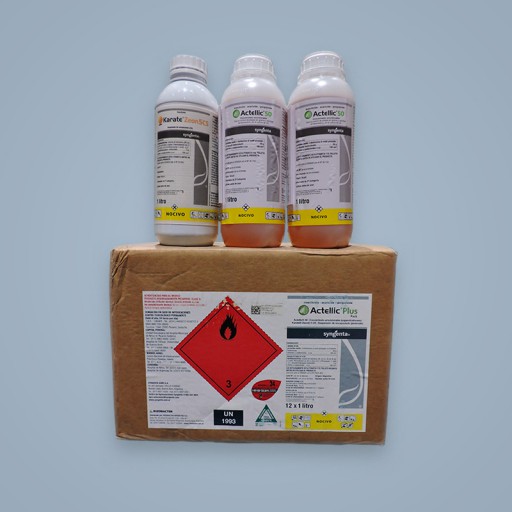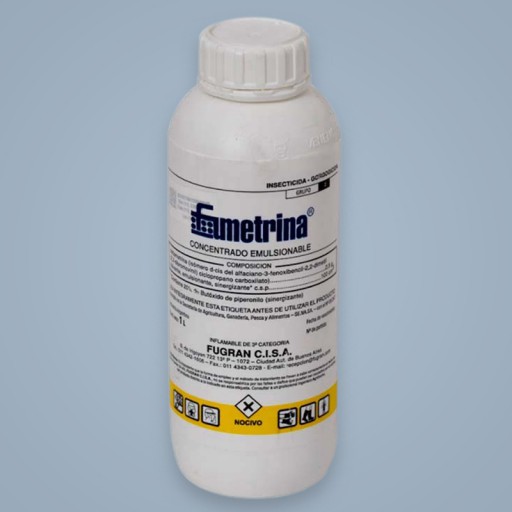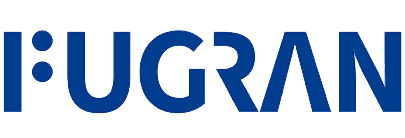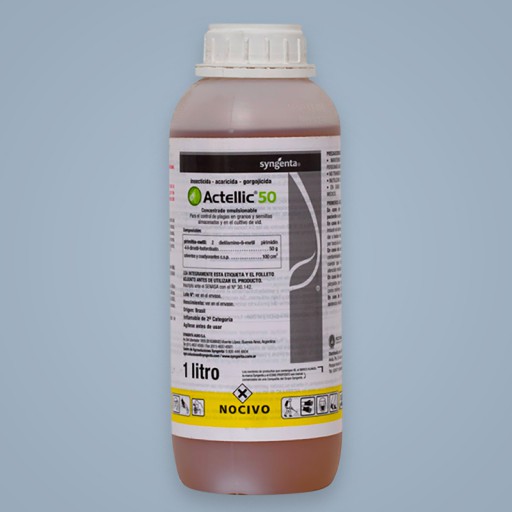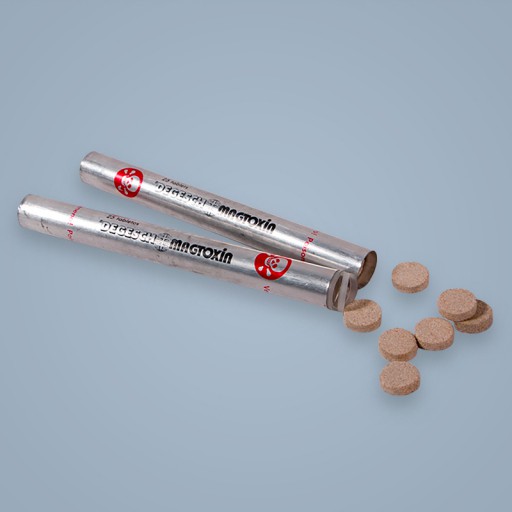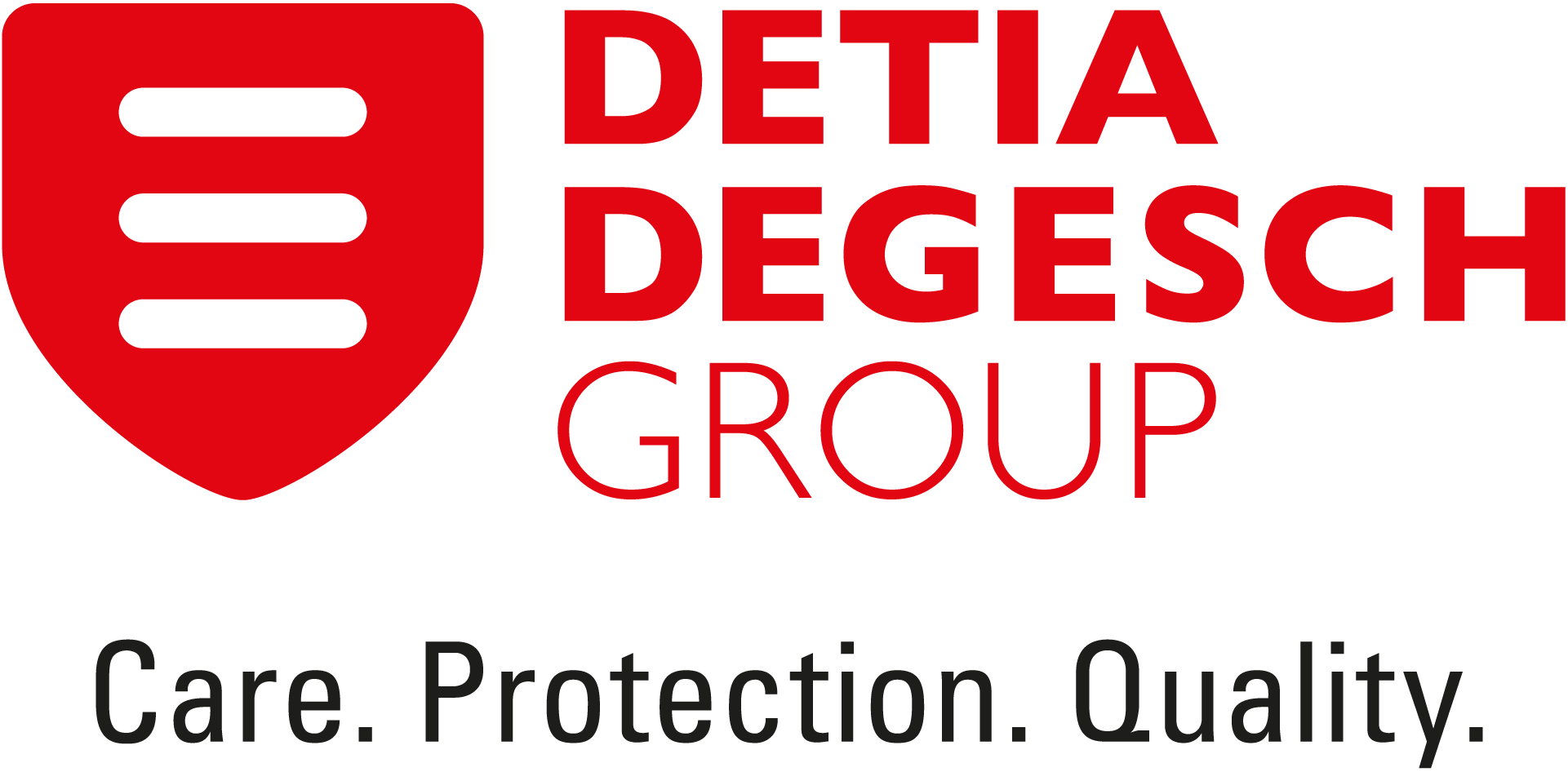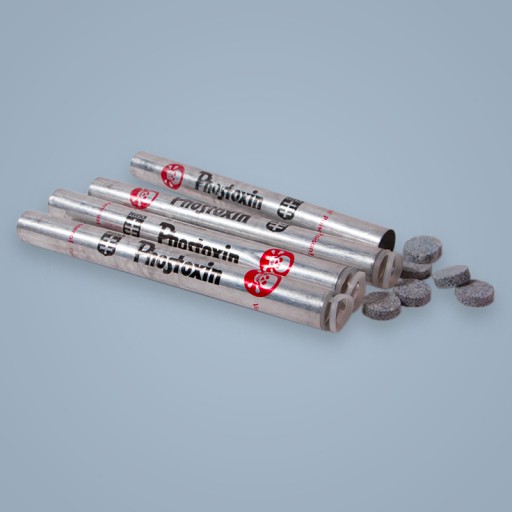
Aluminum Phosphide
Aluminum phosphide (AlP) formulations are the products most frequently used for postharvest pest control as well as to exterminate voles and moles, among others. AlP is formed by the fusion of aluminum and red or yellow phosphorus. On contact with air and moisture it releases the efficient gas phosphine.


Formulation
Pellets (0.6 g) are formed by 60% aluminum phosphide as the reactive substance and 43 - 44% of inert components, such as ammonium carbamate used for the phosphine controlled gasification.
A pellet weighs 0.6 g and releases 0.2 g phosphine.
A pellet weighs 0.6 g and releases 0.2 g phosphine.
The tablets (3 g) contain 56-57% aluminum phosphide as active substance and 43-44% inert components, among others ammonium carbamate for the controlled gasification of phosphine.
One tablet weighs 3 g and releases 1 g phosphine.
One tablet weighs 3 g and releases 1 g phosphine.
Packaging
PH x 480 or MG 432. Aluminum bottles of different sizes with UN approval, flanged and hermetically sealed with a plastic screw cap.
Contents:
RT35 (105 g) RT 50 (150)
Contents:
RT35 (105 g) RT 50 (150)
Tyvek pouches are packaged in resealable foil pouches of various sizes. Depending on the quantity of the bags, it is shipped in metal barrels with UN approval.
Contents:
For each foil bag, we offer pack sizes from 34g single bag to chain and the 34g 100-bag roll.
Contents:
For each foil bag, we offer pack sizes from 34g single bag to chain and the 34g 100-bag roll.
Application
Pellets and tablets gasification starts some time after the fumigation product is exposed to products moisture or atmospheric humidity.
In general, gasification speed depends on the air relative humidity and temperature.
Due to their small size, pellet gasification occurs a bit faster than tablet gasification.
All pests development stages can be controlled with phosphine in stored products. Phosphine effectively controls all four pest development stages, i.e. eggs, larvae, pupae and adults.
This highly efficient gas is able to penetrate in almost all packaging materials, as well as very well packed goods.
Phosphine is corrosive against noble metals (copper, silver, gold) and their alloys. Therefore it is mandatory to protect materials containing noble metals and electronic equipment under phosphine gas-tight tarpaulins or to leave them out of the fumigation area before pellets or tablets are applied.
Application area:
Pellets and tablets use is not restricted to a specific area provided that the area to be fumigated is well sealed and airtight. They are used in silos, ships, warehouses, etc. and they can be applied manually or with Detia Degesch automatic dispenser on the goods to be treated.
In general, gasification speed depends on the air relative humidity and temperature.
Due to their small size, pellet gasification occurs a bit faster than tablet gasification.
All pests development stages can be controlled with phosphine in stored products. Phosphine effectively controls all four pest development stages, i.e. eggs, larvae, pupae and adults.
This highly efficient gas is able to penetrate in almost all packaging materials, as well as very well packed goods.
Phosphine is corrosive against noble metals (copper, silver, gold) and their alloys. Therefore it is mandatory to protect materials containing noble metals and electronic equipment under phosphine gas-tight tarpaulins or to leave them out of the fumigation area before pellets or tablets are applied.
Application area:
Pellets and tablets use is not restricted to a specific area provided that the area to be fumigated is well sealed and airtight. They are used in silos, ships, warehouses, etc. and they can be applied manually or with Detia Degesch automatic dispenser on the goods to be treated.
Bag material (Tyvek) allows safe and controlled gasification. Gasification starts some time after the bags have been removed from transport packaging (foil bag) being in contact with the product mositure or atmospheric humidity. This provides additional safety for the fumigation technician.
All pest development stages can be controlled with phosphine. This highly efficient gas penetrates nearly all packaging materials, as well as well packed merchandise.
Phosphine is corrosive against noble metals (copper, silver, gold) and their alloys. Therefore it is mandatory to protect materials containing noble metals and electronic equipment under phosphine gas-tight tarpaulins or to leave them out of the fumigation area prior to bags application.
Application area
The wide range of packaging options enables comfortable applications in various facilities and objects of all sizes, from small-scale treatment (individual bags) to great-scale treatment such as ships, horizontal silos, as well as in empty areas. As in fumigations with phosphine, it is essential to seal the object to be fumigated by a gas-tight method.
Bags can also be applied directly to the grains or other goods during the silo filling process. In this case the bags must be removed when the silos are emptied. Due to the lack of ammonium carbamate as an inert ingredient, bag products can also be used for sensitive products such as cocoa, tobacco, tea or spices. Bags packaging avoids contamination of fumigated products with phosphine residues (residual powder)
All pest development stages can be controlled with phosphine. This highly efficient gas penetrates nearly all packaging materials, as well as well packed merchandise.
Phosphine is corrosive against noble metals (copper, silver, gold) and their alloys. Therefore it is mandatory to protect materials containing noble metals and electronic equipment under phosphine gas-tight tarpaulins or to leave them out of the fumigation area prior to bags application.
Application area
The wide range of packaging options enables comfortable applications in various facilities and objects of all sizes, from small-scale treatment (individual bags) to great-scale treatment such as ships, horizontal silos, as well as in empty areas. As in fumigations with phosphine, it is essential to seal the object to be fumigated by a gas-tight method.
Bags can also be applied directly to the grains or other goods during the silo filling process. In this case the bags must be removed when the silos are emptied. Due to the lack of ammonium carbamate as an inert ingredient, bag products can also be used for sensitive products such as cocoa, tobacco, tea or spices. Bags packaging avoids contamination of fumigated products with phosphine residues (residual powder)
Phosphine is also highly toxic for human beings and for warm-blooded animals. That is why it is essential to comply with safety measures prescriptions. Products have been especially formulated to increase safety at the time of application. Products contain some ingredients that delay gasification. The simple application method guarantees optimal safety to the user. It must be taken into account that packaging of phosphine releasing products can only be opened in the open air. Products containing magnesium phosphorus should only be used by professionals specialized for said purpose or under their supervision. It is mandatory to meet laws and rules from all countries.
Use Biocidas products carefully. Read the label in detail and follow suggested instructions before using the product. Always use Phytosanitary products in a safe way. Follow use instructions in order to avoid risks for people and the environment.
Use Biocidas products carefully. Read the label in detail and follow suggested instructions before using the product. Always use Phytosanitary products in a safe way. Follow use instructions in order to avoid risks for people and the environment.
